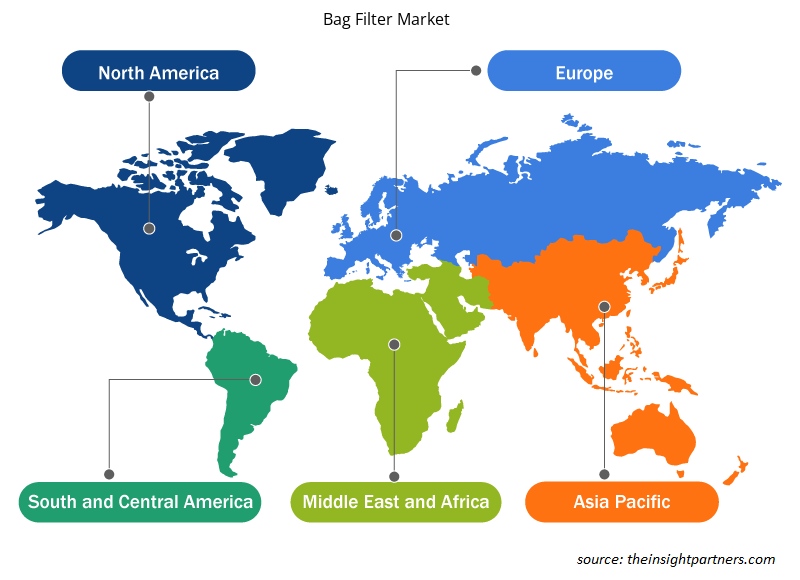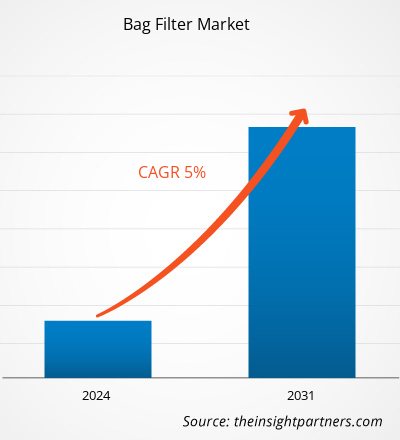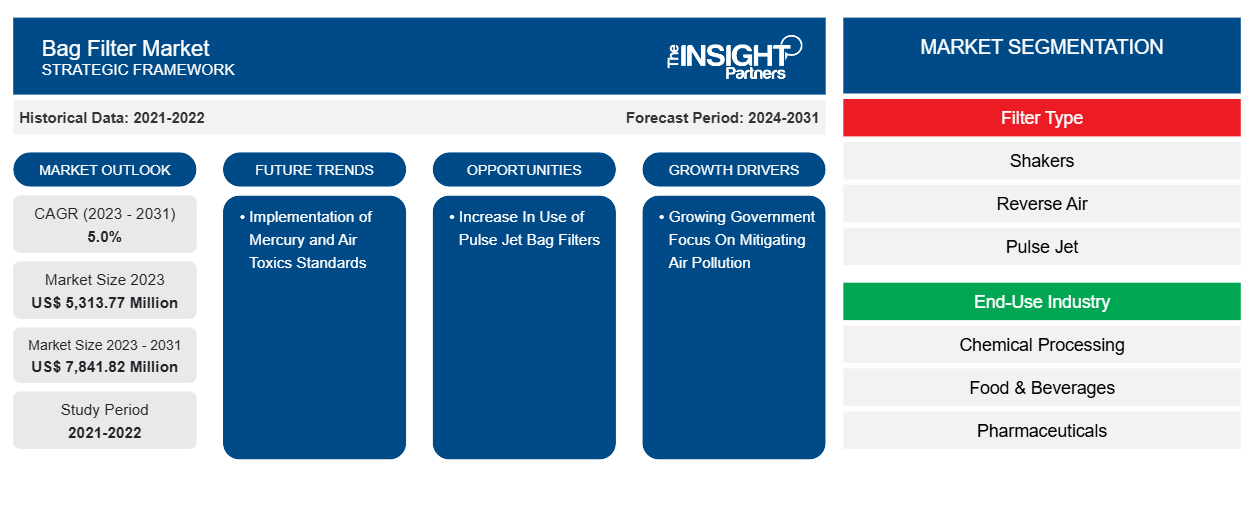Der Markt für Beutelfilter soll von 5.313,77 Millionen US-Dollar im Jahr 2023 auf 7.841,82 Millionen US-Dollar im Jahr 2031 anwachsen. Der Markt wird zwischen 2023 und 2031 voraussichtlich eine durchschnittliche jährliche Wachstumsrate von 5,0 % verzeichnen. Die Anwendung von Standards für Quecksilber und Luftschadstoffe dürfte ein wichtiger Trend auf dem Markt bleiben.
Beutelfilter Marktanalyse
Beutelfiltergehäuse, die in der Bergbau- und Chemieindustrie verwendet werden, haben oft einen ASME-Stempel und müssen aus rostfreiem Stahl bestehen. Der Filtrationsprozess muss in der Regel strenge Anforderungen erfüllen und häufig in der Lage sein, Partikel kleiner als ein Mikron herauszufiltern. Funktionsfähige Beutelfilter haben in der Regel eine Partikelabscheideleistung von 99 % oder mehr, unabhängig von den extrem kleinen Partikelgrößen, im Gegensatz zu Elektrofiltern, deren Leistung je nach Prozess und elektrischen Bedingungen stark variieren kann. Einige Beutelfilter sind mit Ultraschallhörnern ausgestattet, die zusätzliche Vibrationen erzeugen, um die Staubentfernung zu verbessern. Die Hörner werden kurz vor oder zu Beginn des Reinigungszyklus aktiviert, um die Bindungen zwischen den Partikeln auf der Oberfläche des Filtermediums aufzubrechen. In Industrieländern in Nordamerika und Westeuropa wurden mehrere neue Beschränkungen eingeführt, um schädliche Industrieemissionen einzudämmen. Häufige Gesetzesänderungen erfordern eine häufige Modernisierung oder Aufrüstung von Beutelfiltersystemen in Industrieanlagen.
Marktübersicht für Beutelfilter
Auf dem Markt sind Beutelfilter in verschiedenen Konfigurationen erhältlich, die speziell auf die betrieblichen Anforderungen zugeschnitten sind. Von Standardbeutelfiltern bis hin zu kundenspezifischen Produkten bieten Hersteller ihren Kunden unterschiedliche Produkttypen an. Aufgrund ihrer geringen Kosten und hohen Zuverlässigkeit werden industrielle Beutelfilter häufig in der Lebensmittel- und Getränkeindustrie eingesetzt. Umkehrosmose- oder Beutelfilter mit Aktivkohle werden häufig verwendet, um Wasser von Verunreinigungen zu reinigen.
Passen Sie diesen Bericht Ihren Anforderungen an
Sie erhalten kostenlos individuelle Anpassungen an jedem Bericht, einschließlich Teilen dieses Berichts oder einer Analyse auf Länderebene, eines Excel-Datenpakets sowie tolle Angebote und Rabatte für Start-ups und Universitäten.
-
Holen Sie sich die wichtigsten Markttrends aus diesem Bericht.Dieses KOSTENLOSE Beispiel umfasst eine Datenanalyse von Markttrends bis hin zu Schätzungen und Prognosen.
Markttreiber und Chancen für Beutelfilter
Wachsender Fokus der Regierung auf die Eindämmung der Luftverschmutzung zur Förderung des Marktes
Mit dem Ziel, die Auswirkungen industrieller Emissionen zu reduzieren und die Emissionswerte des Industriesektors zu senken, erlassen die Regierungen verschiedener Länder Gesetze und Vorschriften zur Eindämmung der Luftverschmutzung. Die zunehmende Entwicklung und Expansion des Industriesektors zusammen mit der zunehmenden Urbanisierung wird voraussichtlich zu einer Erhöhung der Luftverschmutzung führen, was sich direkt auf die Gesundheit auswirkt und die Zahl der durch die Luft übertragenen Krankheiten erhöht. Der zunehmende Fokus der Regierung auf die Senkung der Luftverschmutzung lenkt daher den Fokus auf die Umsetzung strenger Richtlinien für den Industriesektor, was die Nachfrage nach Beutelfiltern weltweit antreibt.pollutiomn. The growing development and expansion of industrial sector along with risinmg urbanization is projected to increase the level of air pollution, which is directly impacting the health and rising the number of airborne diseases. Thus, the growing government focus on lowering the levels of air pollution is steering the government focus on implementing strict policies on the industrial sector which is driving the demand for bag filters globally.
Zunehmender Einsatz von Pulse-Jet-Beutelfiltern
Um die Sicherheitsanforderungen an die Luftqualität am Arbeitsplatz zu erfüllen, sind Pulse-Jet-Beutelfilter eine der beliebtesten Arten von Luftverschmutzungskontrollgeräten . Die Pulse-Jet-Staubsammler sind in erster Linie dafür ausgelegt, potenziell giftige Partikel und Emissionen effektiv aufzufangen und zu reduzieren. Die Effizienz von Pulse-Jet-Filtern steigert ihre Anwendung weltweit.
Beutelfilter Marktbericht Segmentierungsanalyse
Wichtige Segmente, die zur Ableitung der Beutelfilter-Marktanalyse beigetragen haben, sind Filtertyp und Endverbrauchsindustrie.
- Basierend auf dem Filtertyp ist der Beutelfiltermarkt in Shaker, Rückluft und Pulse-Jet-Filter unterteilt. Das Pulse-Jet-Segment hatte im Jahr 2023 einen größeren Marktanteil.
- Nach Endverbrauchsbranche ist der Markt in chemische Verarbeitung, Lebensmittel und Getränke, Pharmazeutika, Papier und Zellstoff, Wasseraufbereitung und andere unterteilt. Das Segment der chemischen Verarbeitung hielt im Jahr 2023 einen erheblichen Marktanteil.
Beutelfilter Marktanteilsanalyse nach Geografie
Der geografische Umfang des Beutelfilter-Marktberichts ist hauptsächlich in fünf Regionen unterteilt: Nordamerika, Asien-Pazifik, Europa, Naher Osten und Afrika sowie Süd- und Mittelamerika.
Nordamerika ist Marktführer. Die USA sind Marktführer für Beutelfilter in Nordamerika. Die wachsende Entwicklung im Industriesektor und der zunehmende Fokus der Regierung auf die Eindämmung der Luftverschmutzung durch den Industriesektor treiben das Wachstum des Beutelfiltermarktes in Nordamerika voran. Länder wie Großbritannien, Frankreich, Deutschland und Belgien sind die wenigen Länder mit einer größeren Anzahl an Chemie- und Lebensmittelindustrien, was das Wachstum in ganz Europa vorantreibt. Die steigende Anzahl an Wasser- und Abwasseraufbereitungsanlagen im asiatisch-pazifischen Raum wirkt sich positiv auf den Beutelfiltermarkt im gesamten asiatisch-pazifischen Raum aus.
Regionale Einblicke in den Beutelfiltermarkt
Die regionalen Trends und Faktoren, die den Beutelfiltermarkt während des Prognosezeitraums beeinflussen, wurden von den Analysten von Insight Partners ausführlich erläutert. In diesem Abschnitt werden auch Beutelfiltermarktsegmente und -geografie in Nordamerika, Europa, im asiatisch-pazifischen Raum, im Nahen Osten und Afrika sowie in Süd- und Mittelamerika erörtert.

- Erhalten Sie regionale Daten zum Beutelfiltermarkt
Umfang des Marktberichts über Beutelfilter
| Berichtsattribut | Details |
|---|---|
| Marktgröße im Jahr 2023 | 5.313,77 Millionen US-Dollar |
| Marktgröße bis 2031 | 7.841,82 Millionen US-Dollar |
| Globale CAGR (2023 - 2031) | 5,0 % |
| Historische Daten | 2021-2022 |
| Prognosezeitraum | 2024–2031 |
| Abgedeckte Segmente |
Nach Filtertyp
|
| Abgedeckte Regionen und Länder |
Nordamerika
|
| Marktführer und wichtige Unternehmensprofile |
|
Marktteilnehmerdichte: Der Einfluss auf die Geschäftsdynamik
Der Markt für Beutelfilter wächst rasant, angetrieben durch die steigende Nachfrage der Endverbraucher aufgrund von Faktoren wie sich entwickelnden Verbraucherpräferenzen, technologischen Fortschritten und einem größeren Bewusstsein für die Vorteile des Produkts. Mit steigender Nachfrage erweitern Unternehmen ihr Angebot, entwickeln Innovationen, um die Bedürfnisse der Verbraucher zu erfüllen, und nutzen neue Trends, was das Marktwachstum weiter ankurbelt.
Die Marktteilnehmerdichte bezieht sich auf die Verteilung der Firmen oder Unternehmen, die in einem bestimmten Markt oder einer bestimmten Branche tätig sind. Sie gibt an, wie viele Wettbewerber (Marktteilnehmer) in einem bestimmten Marktraum im Verhältnis zu seiner Größe oder seinem gesamten Marktwert präsent sind.
Die wichtigsten auf dem Beutelfiltermarkt tätigen Unternehmen sind:
- Babcock & Wilcox Enterprises Inc.
- BWF Offermann, Waldenfels & Co. KG
- Camfil
- Danaher Corporation
- Donaldson Company, Inc.
- Eaton Corporation plc
Haftungsausschluss : Die oben aufgeführten Unternehmen sind nicht in einer bestimmten Reihenfolge aufgeführt.

- Überblick über die wichtigsten Akteure auf dem Beutelfiltermarkt
Neuigkeiten und aktuelle Entwicklungen zum Beutelfiltermarkt
Der Beutelfiltermarkt wird durch die Erhebung qualitativer und quantitativer Daten nach Primär- und Sekundärforschung bewertet, die wichtige Unternehmensveröffentlichungen, Verbandsdaten und Datenbanken umfasst. Nachfolgend sind einige der Entwicklungen auf dem Beutelfiltermarkt aufgeführt:
- Parker Hannifin Corp. hat einen gefalteten Schlauchfilter für den Einsatz in Anwendungen mit extremer Hitze auf den Markt gebracht. (Quelle: Parker Hannifin Corp, Pressemitteilung, Mai 2022)
- Babcock & Wilcox übernimmt FPS. Die Übernahme von Fossil Power Systems, Inc., einem renommierten Hersteller von Verbrennungsanlagen für Erdgas, Wasserstoff sowie erneuerbaren Zellstoff und Papier, wurde von Babcock and Wilcox Enterprises, Inc. angekündigt. (Quelle: Babcock & Wilcox, Pressemitteilung, Februar 2022)
Marktbericht zu Beutelfiltern – Umfang und Ergebnisse
Der Bericht „Marktgröße und Prognose für Beutelfilter (2021–2031)“ bietet eine detaillierte Analyse des Marktes, die die folgenden Bereiche abdeckt:
- Beutelfiltermarktgröße und -prognose auf globaler, regionaler und Länderebene für alle wichtigen Marktsegmente, die im Rahmen des Berichts abgedeckt sind
- Markttrends für Beutelfilter sowie Marktdynamik wie Treiber, Einschränkungen und wichtige Chancen
- Detaillierte PEST- und SWOT-Analyse
- Beutelfilter-Marktanalyse mit wichtigen Markttrends, globalen und regionalen Rahmenbedingungen, wichtigen Akteuren, Vorschriften und aktuellen Marktentwicklungen
- Branchenlandschaft und Wettbewerbsanalyse, einschließlich Marktkonzentration, Heatmap-Analyse, prominenten Akteuren und aktuellen Entwicklungen auf dem Beutelfiltermarkt
- Detaillierte Firmenprofile
- Historische Analyse (2 Jahre), Basisjahr, Prognose (7 Jahre) mit CAGR
- PEST- und SWOT-Analyse
- Marktgröße Wert/Volumen – Global, Regional, Land
- Branchen- und Wettbewerbslandschaft
- Excel-Datensatz
Aktuelle Berichte
Erfahrungsberichte
Grund zum Kauf
- Fundierte Entscheidungsfindung
- Marktdynamik verstehen
- Wettbewerbsanalyse
- Kundeneinblicke
- Marktprognosen
- Risikominimierung
- Strategische Planung
- Investitionsbegründung
- Identifizierung neuer Märkte
- Verbesserung von Marketingstrategien
- Steigerung der Betriebseffizienz
- Anpassung an regulatorische Trends























 Kostenlose Probe anfordern für - Markt für Beutelfilter
Kostenlose Probe anfordern für - Markt für Beutelfilter